lights CHEVROLET ASTRO PASSENGER 1994 1.G User Guide
[x] Cancel search | Manufacturer: CHEVROLET, Model Year: 1994, Model line: ASTRO PASSENGER, Model: CHEVROLET ASTRO PASSENGER 1994 1.GPages: 340, PDF Size: 16.86 MB
Page 105 of 340
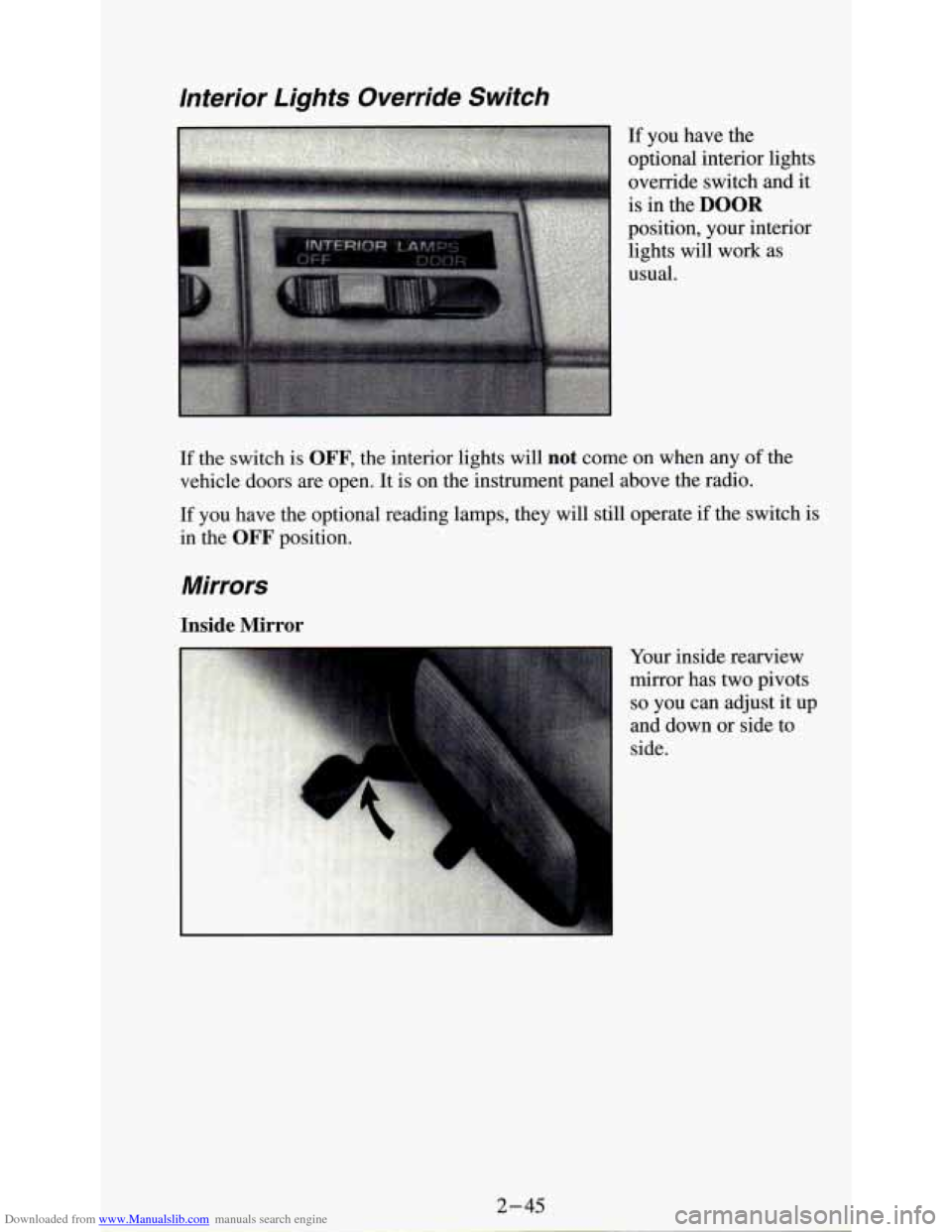
Downloaded from www.Manualslib.com manuals search engine Interior Lights Override Switch
If you have the
optional interior lights
override switch and it
is
in the DOOR
position, your interior
lights will work as
usual.
If the switch is
OFF, the interior lights will not come on when any of the
vehicle doors are open. It is on the instrument panel above the radio.
If you have the optional reading lamps, they will still operate if the switch is
in the
OFF position.
Mirrors
Inside Mirror
Your inside rearview
mirror has two pivots
so you can adjust it up
and down or side to
side.
Page 107 of 340
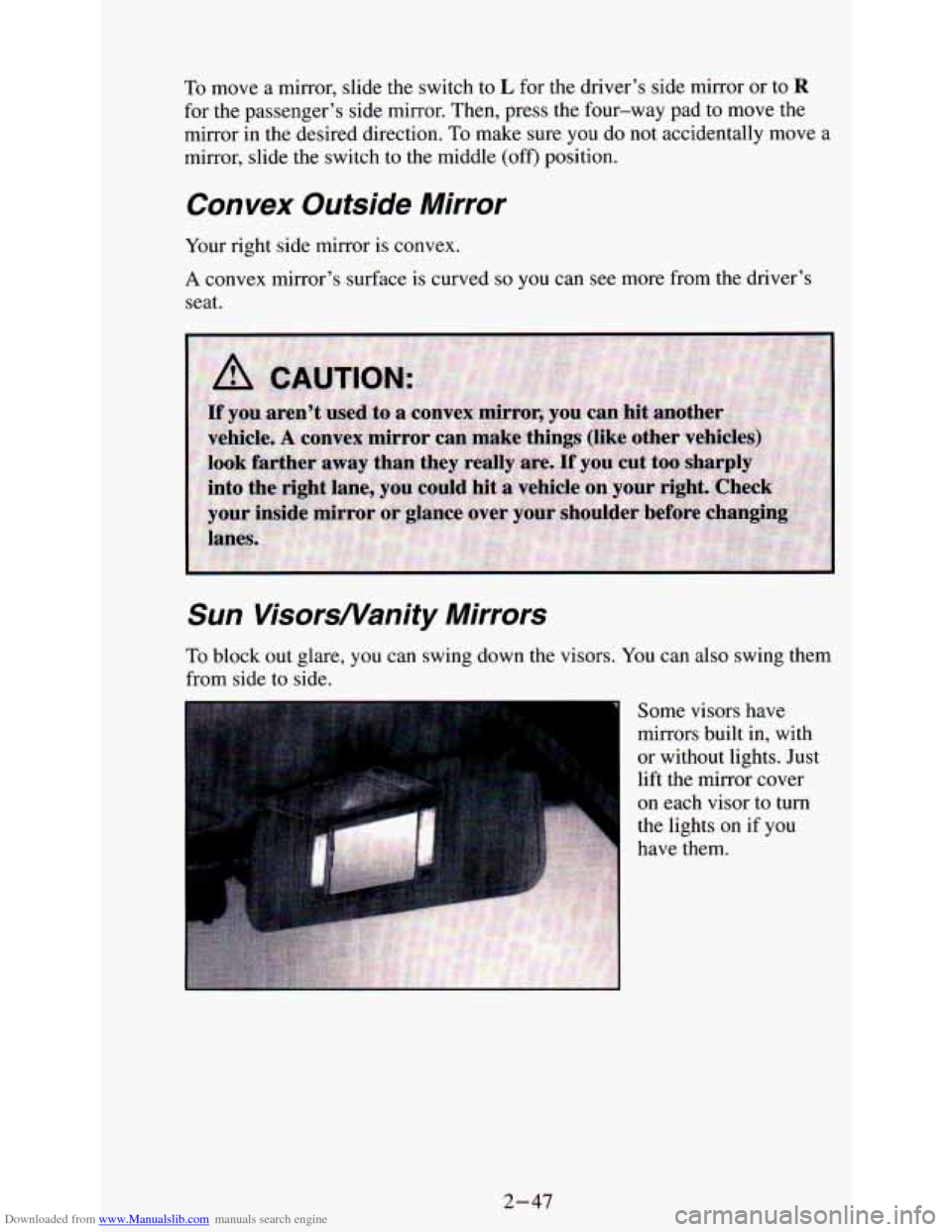
Downloaded from www.Manualslib.com manuals search engine To move a mirror, slide the switch to L for the driver’s side mirror or to R
for the passenger’s side mirror. Then, press the four-way pad to move the
mirror in the desired direction. To make sure you do not accidentally move
a
mirror, slide the switch to the middle (off) position.
Convex Outside Mirror
Your right side mirror is convex.
A convex mirror’s surface is curved so you can see more from the driver’s
seat.
Sun VisorsNanity Mirrors
To block out glare, you can swing down the visors. You can also swing them
from side to side.
Some visors have
mirrors built in, with
or without lights. Just
lift the mirror cover
on each visor to turn
the lights on if you
have them.
2-47
Page 115 of 340
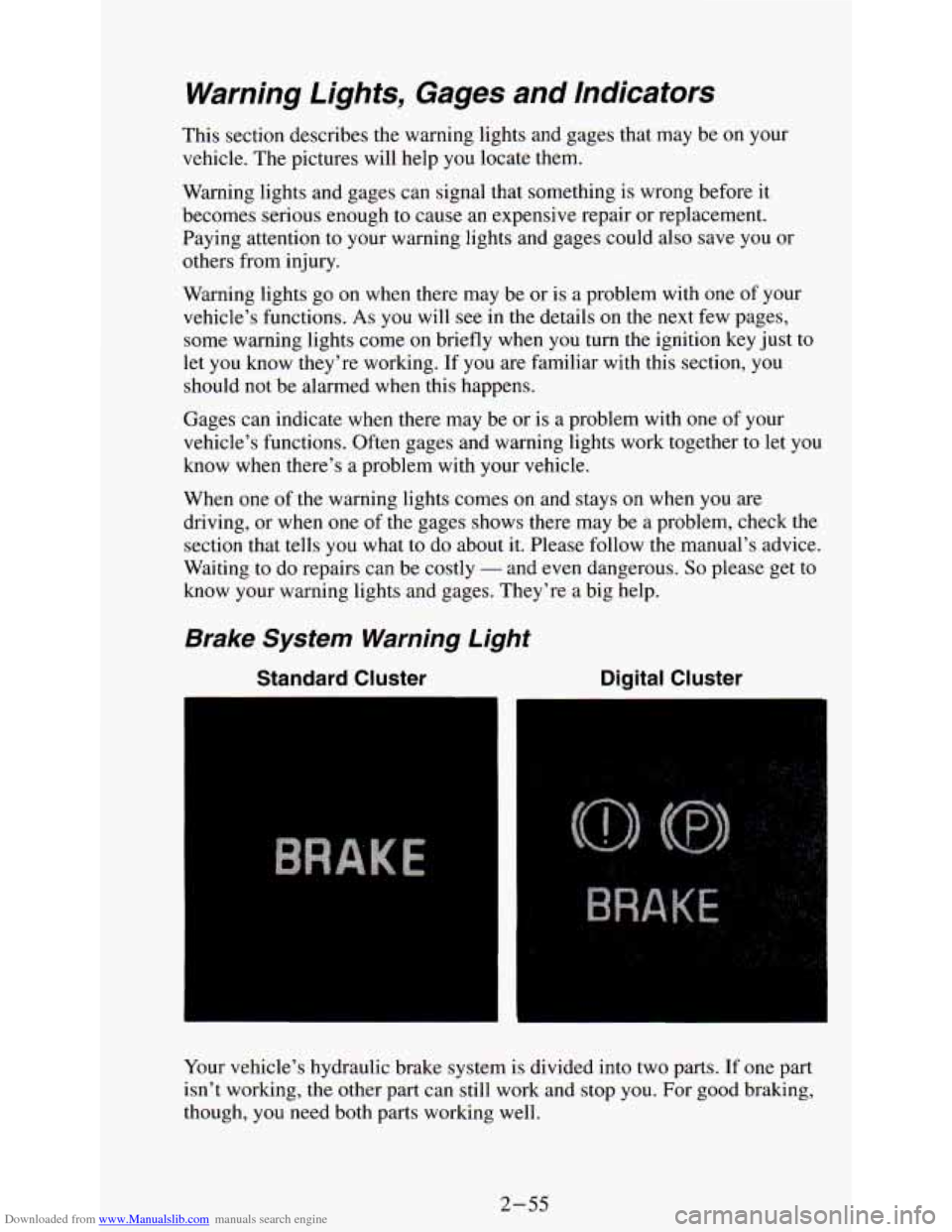
Downloaded from www.Manualslib.com manuals search engine Warning Lights, Gages and Indicators
This section describes the warning lights and gages that may be on your
vehicle. The pictures will help you locate them.
Warning lights and gages can signal that something is wrong before it
becomes serious enough to cause an expensive repair or replacement.
Paying attention
to your warning lights and gages could also save you or
others from injury.
Warning lights go on when there may be or is a problem with
one of your
vehicle’s functions.
As you will see in the details on the next few pages,
some warning lights come on briefly when
you turn the ignition key just to
let you know they’re working. If you are familiar with this section, you
should not be alarmed when this happens.
Gages can indicate when there may be or
is a problem with one of your
vehicle’s functions. Often gages and warning lights work together to let you
know when there’s a problem with your vehicle.
When one of the warning lights comes
on and stays on when you are
driving, or when one
of the gages shows there may be a problem, check the
section that tells you what
to do about it. Please follow the manual’s advice.
Waiting to do repairs can be costly
- and even dangerous. So please get to
know your warning lights and gages. They’re a big help.
Brake System Warning Light
Standard Cluster Digital Cluster
Your
vehicle’s hydraulic brake system is divided into two parts. If one part
isn’t working,
the other part can still work and stop you. For good braking,
though,
you need both parts working well.
2-55
Page 117 of 340
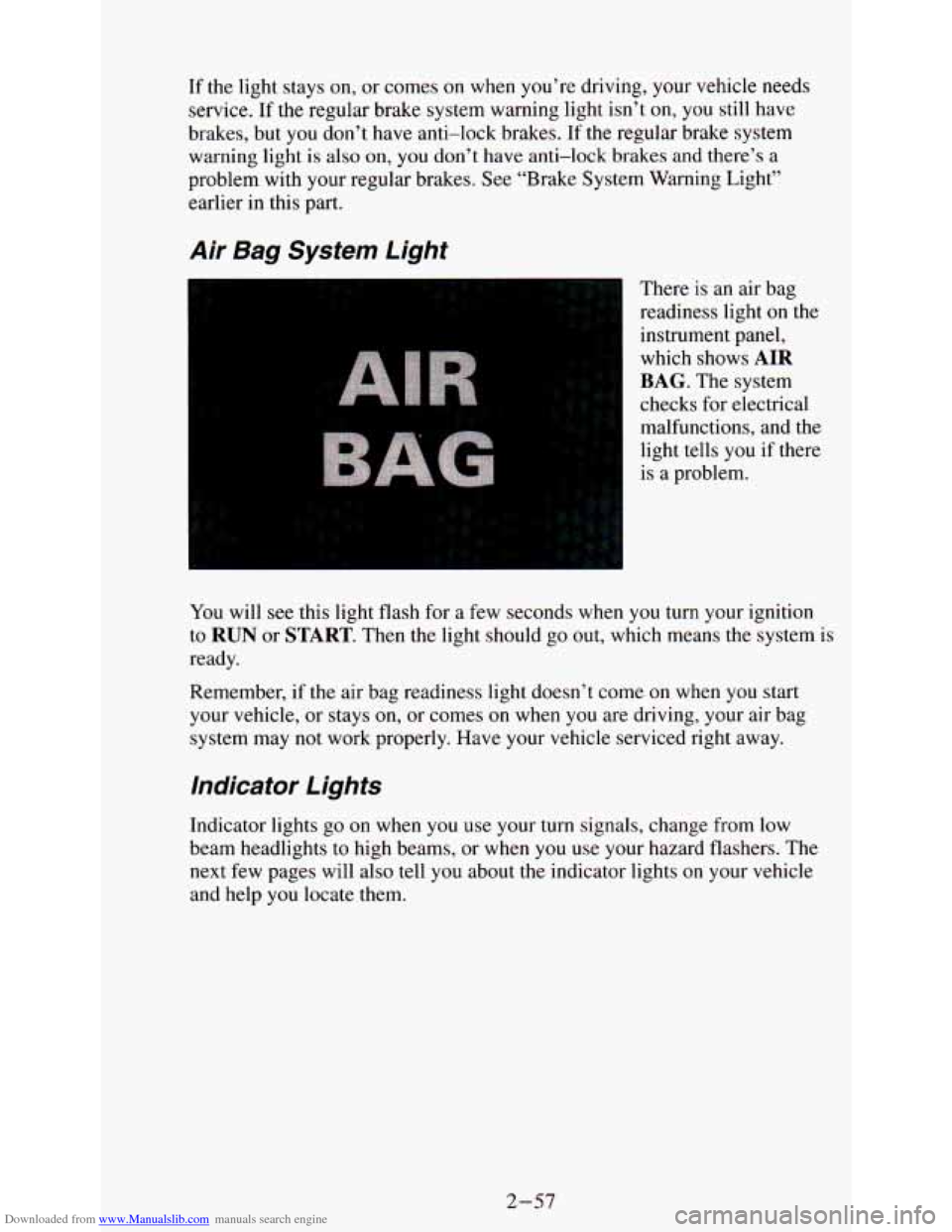
Downloaded from www.Manualslib.com manuals search engine If the light stays on, or comes on when you’re driving, your vehicle needs
service. If the regular brake system warning light isn’t
on, you still have
brakes, but you don’t have anti-lock brakes. If the regular brake system
warning light is also on,
you don’t have anti-lock brakes and there’s a
problem with your regular brakes. See “Brake System Warning Light”
earlier in this part.
Air Bag System Light
There is an air bag
readiness light
on the
instrument panel,
which shows
AIR
BAG. The system
checks for electrical
malfunctions, and the
light tells
you if there
is a problem.
You will
see this light flash for a few seconds when you turn your ignition
to
RUN or START. Then the light should go out, which means the system is
ready.
Remember, if the air bag readiness light doesn’t come
on when you start
your vehicle, or stays
on, or comes on when you are driving, your air bag
system may not work properly. Have your vehicle serviced right \
away.
Indicator Lights
Indicator lights go on when you use your turn signals, change from low
beam headlights to high beams, or when
you use your hazard flashers. The
next few pages will also tell you about the indicator lights on your vehicle
and help
you locate them.
2-57
Page 120 of 340
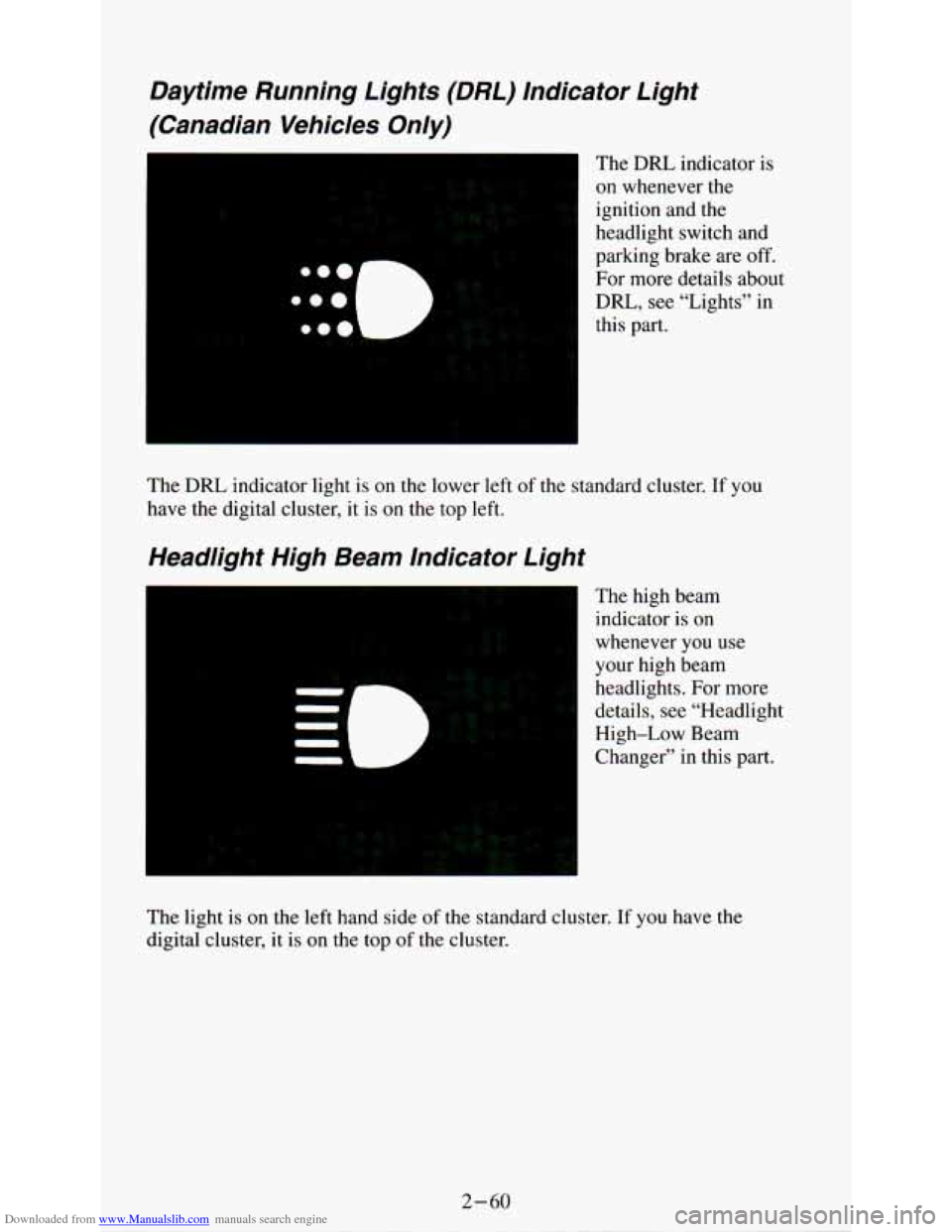
Downloaded from www.Manualslib.com manuals search engine Daytime Running Lights (DRL) lndicator Light
(Canadian Vehicles Only)
L,
The DRL indicator is
on whenever the
ignition and the
headlight switch and
parking brake are off.
For more details about
DRL, see “Lights” in
this part.
The
DRL indicator light is on the lower left of the standard cluster. If you
have the digital cluster, it is
on the top left.
Headlight High Beam Indicator Light
The high beam
indicator is on
whenever
you use
your high beam
headlights. For more
details, see “Headlight
High-Low Beam
Changer” in this part.
The light
is on the left hand side of the standard cluster. If you have the
digital cluster, it is on the top of the cluster.
Page 165 of 340
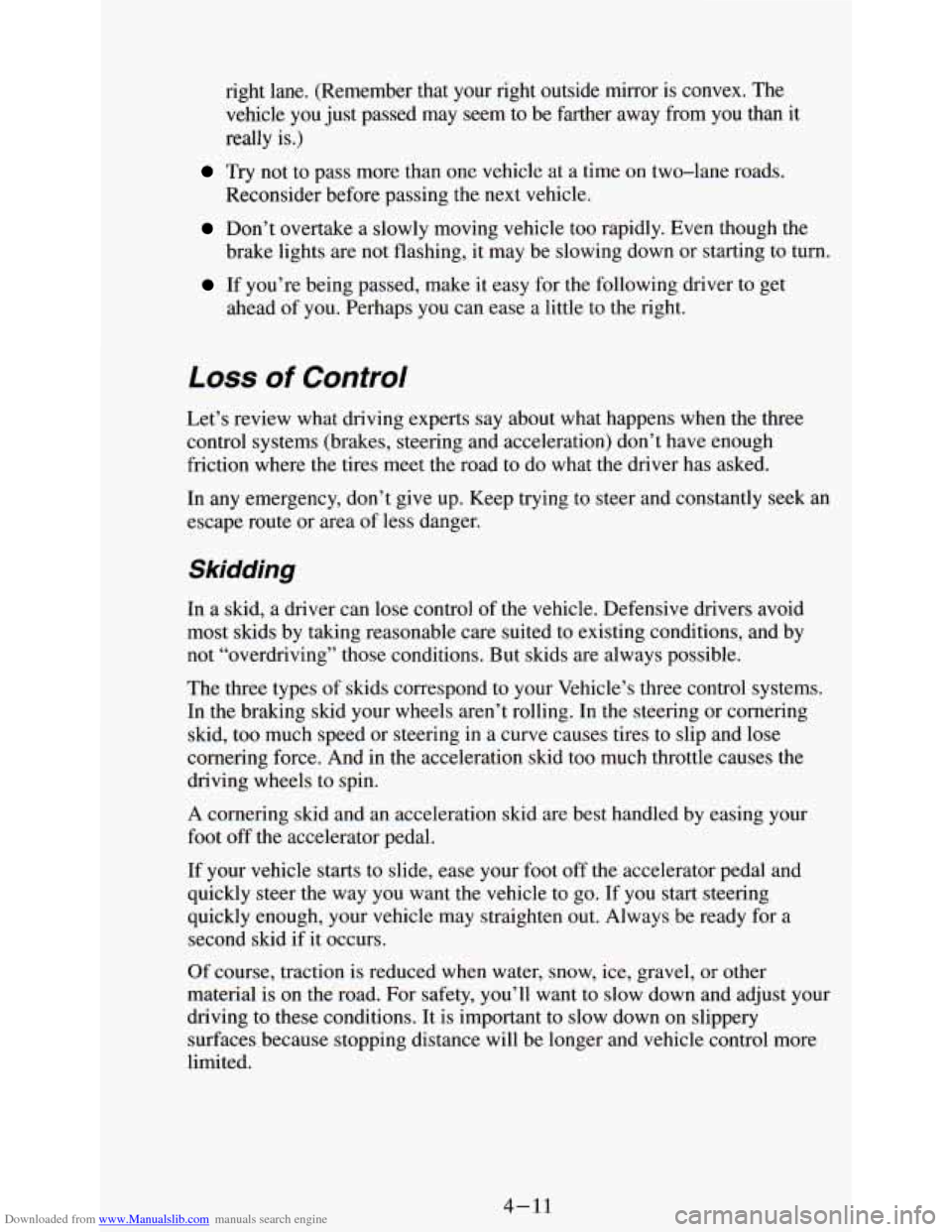
Downloaded from www.Manualslib.com manuals search engine right lane. (Remember that your right outside mirror is convex\
. The vehicle you just passed may seem to be farther away from you than
it
really is.)
Try not to pass more than one vehicle at a time on two-lane roads.
Reconsider before passing the
next vehicle.
Don’t overtake a slowly moving vehicle too rapidly. Even though the
brake lights are not flashing, it may be slowing down or starting to turn.
If you’re being passed, make it easy for the following driver to get
ahead of you. Perhaps you can ease a little to the right.
Loss of Control
Let’s review what driving experts say about what happens when the three
control systems (brakes, steering and acceleration) don’t have enough
friction where the tires meet the road to do what the driver has asked.
In any emergency, don’t give up. Keep
trying to steer and const tly seek an
escape route or area of less danger.
Skidding
In a skid, a driver can lose control of the vehicle. Defensive drivers avoid
most skids by taking reasonable care suited to existing conditions, and by
not “overdriving” those conditions. But skids are always possible.
The three types of skids correspond to your Vehicle’s three control systems.
In the braking skid your wheels aren’t rolling. In the steering or cornering
skid, too much speed or steering in a curve causes tires to slip and lose
cornering force. And in the acceleration skid too much throttle causes the
driving wheels to spin.
A cornering skid and an acceleration skid are best handled by easing your
foot off the accelerator pedal.
If your vehicle starts to slide, ease your foot off the accelerator pedal and
quickly steer the
way you want the vehicle to go. If you start steering
quickly enough, your vehicle may straighten out. Always be ready for a
second skid if it occurs.
Of course, traction
is reduced when water, snow, ice, gravel, or other
material is on the road. For safety, you’ll
want to slow down and adjust your
driving to these conditions. It is important to slow down on slippery
surfaces because stopping distance will be longer and vehicle control more
limited.
4-11
Page 166 of 340
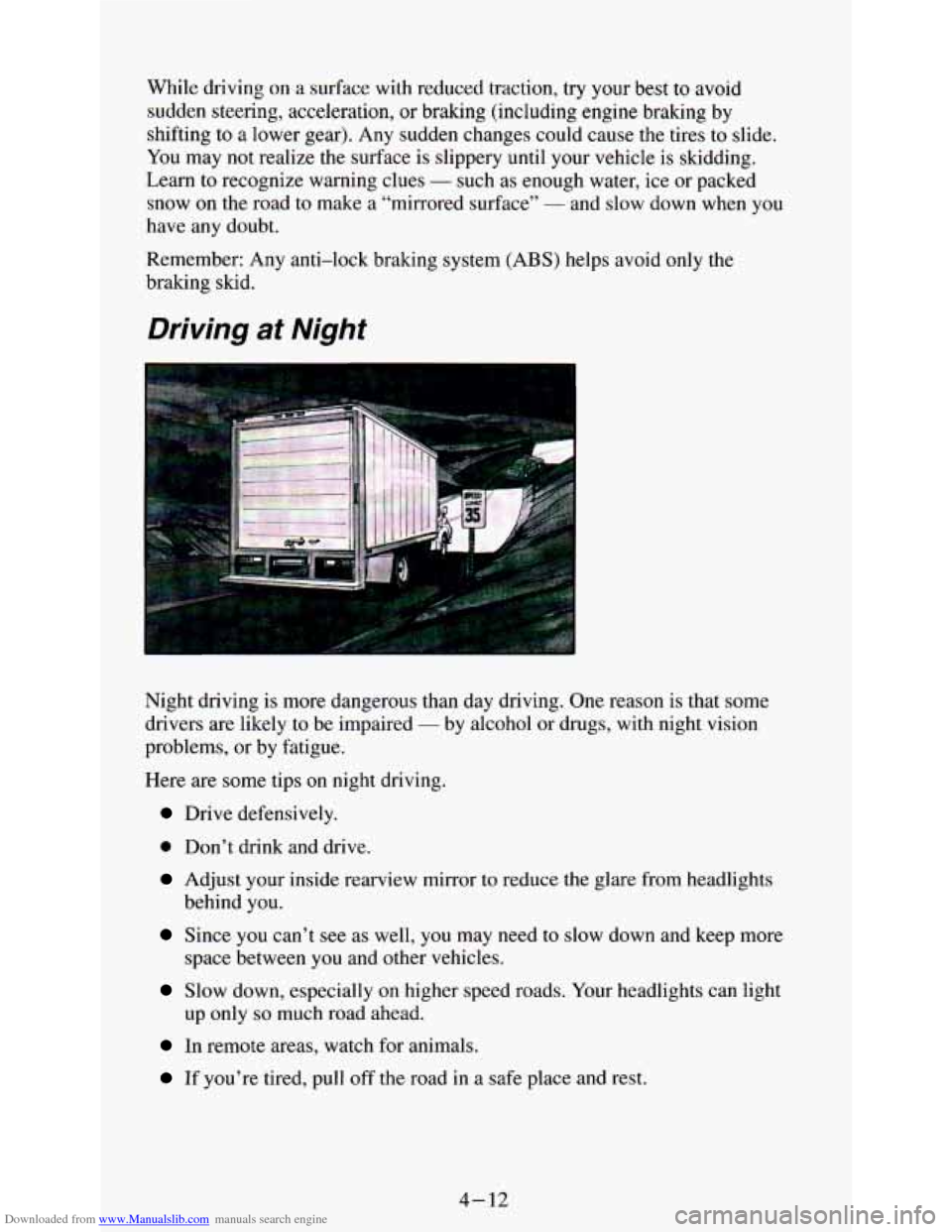
Downloaded from www.Manualslib.com manuals search engine While driving on a surface with reduced traction, try your best to avoid
sudden steering, acceleration,
or bralung (including engine braking by
shifting to
a lower gear). Any sudden changes could cause the tires to slide.
You may
not realize the surface is slippery until your vehicle is skidding.
Learn to recognize warning clues
- such as enough water, ice or packed
snow on the road to make
a “mirrored surface” - and slow down when you
have any doubt.
Remember: Any anti-lock braking system
(ABS) helps avoid only the
braking skid.
Driving at Night
Night driving is more dangerous than day driving. One reason is that some
drivers are likely to be impaired
- by alcohol or drugs, with night vision
problems, or by fatigue.
Here are some tips
on night driving.
Drive defensively.
0 Don’t drink and drive.
Adjust your inside rearview mirror to reduce the glare from headlights
behind
you.
Since you can’t see as well, you may need to slow down and keep more
Slow down, especially on higher speed roads. Your headlights can light
In remote areas, watch for animals.
If you’re tired, pull off the road in a safe place and rest.
space
between
you and other vehicles.
up only
so much road ahead.
4-12
Page 167 of 340
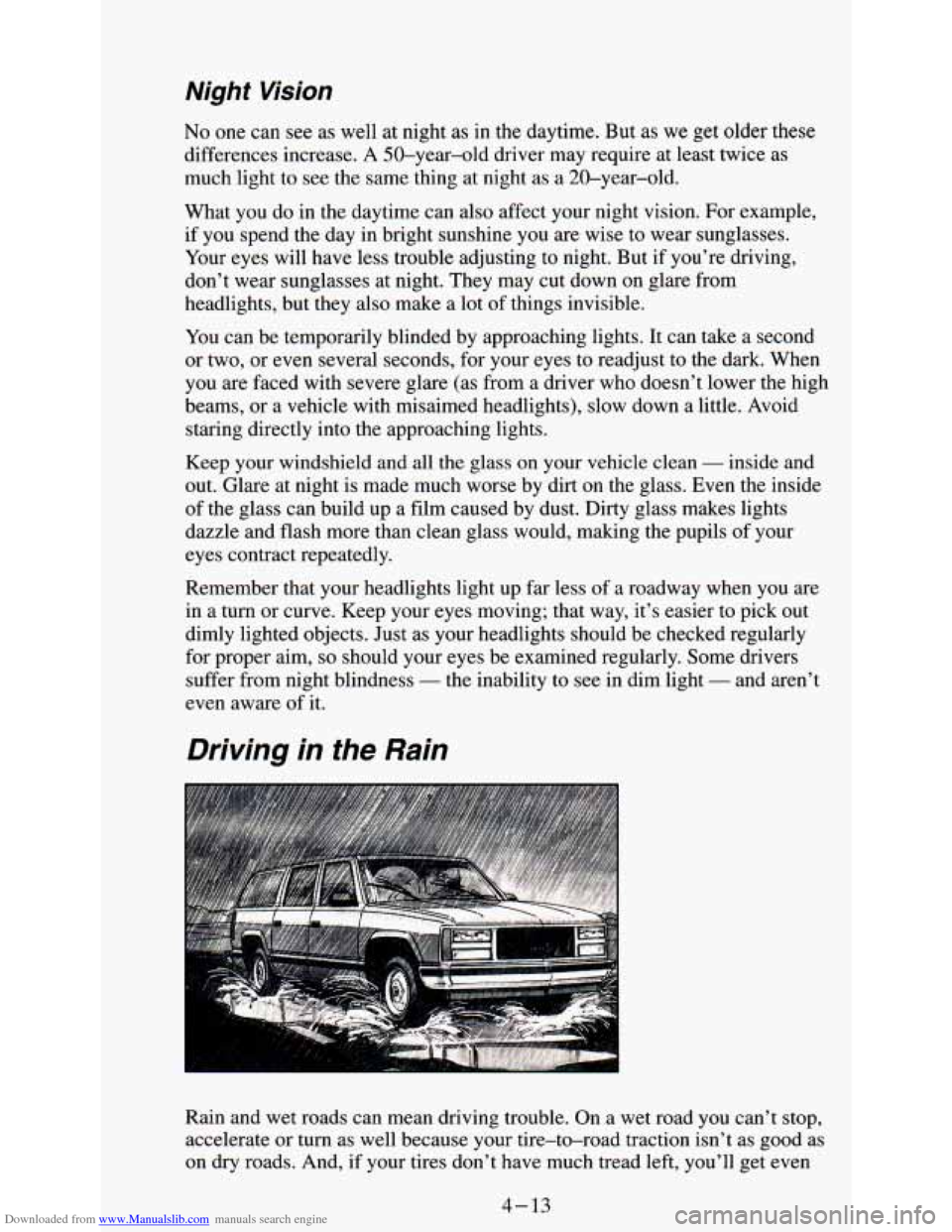
Downloaded from www.Manualslib.com manuals search engine Night Vision
No one can see as well at night as in the daytime. But as we get older these
differences increase.
A 50-year-old driver may require at least twice as
much light to see the same thing at night as a 20-year-old.
What you do in
the daytime can also affect your night vision. For example,
if you spend the day in bright sunshine you are wise to wear sunglasses.
Your eyes will have less trouble adjusting to night. But if you’re driving,
don’t wear sunglasses at night. They may cut down on glare from
headlights, but they also make a lot of things invisible.
You can be temporarily blinded by approaching lights. It can take a second
or two, or even several seconds, for your eyes to readjust to the dark. When
you are faced with severe glare (as from a driver who doesn’t lowe\
r the high
beams, or a vehicle with misaimed headlights), slow down a little. Avoid
staring directly into the approaching lights.
Keep your windshield and all the glass on your vehicle clean
- inside and
out. Glare at night is made much worse by dirt on the glass. Even the inside
of the glass can build up a film caused by dust. Dirty glass makes lights
dazzle and flash more than clean glass would, making the pupils of y\
our
eyes contract repeatedly.
Remember that your headlights light up far less
of a roadway when you are
in a turn or curve. Keep your eyes moving; that way, it’s easier to pick out
dimly lighted objects. Just as your headlights should be checke\
d regularly
for proper aim,
so should your eyes be examined regularly. Some drivers
suffer from night blindness
- the inability to see in dim light - and aren’t
even aware of
it.
Driving in the Rain
Rain and wet roads can mean driving trouble. On a wet road you can’t stop,
accelerate or turn as well because your tire-to-road traction isn’t as goo\
d as
on dry roads. And, if your tires don’t have much tread left, you’ll get even
4-13
Page 169 of 340
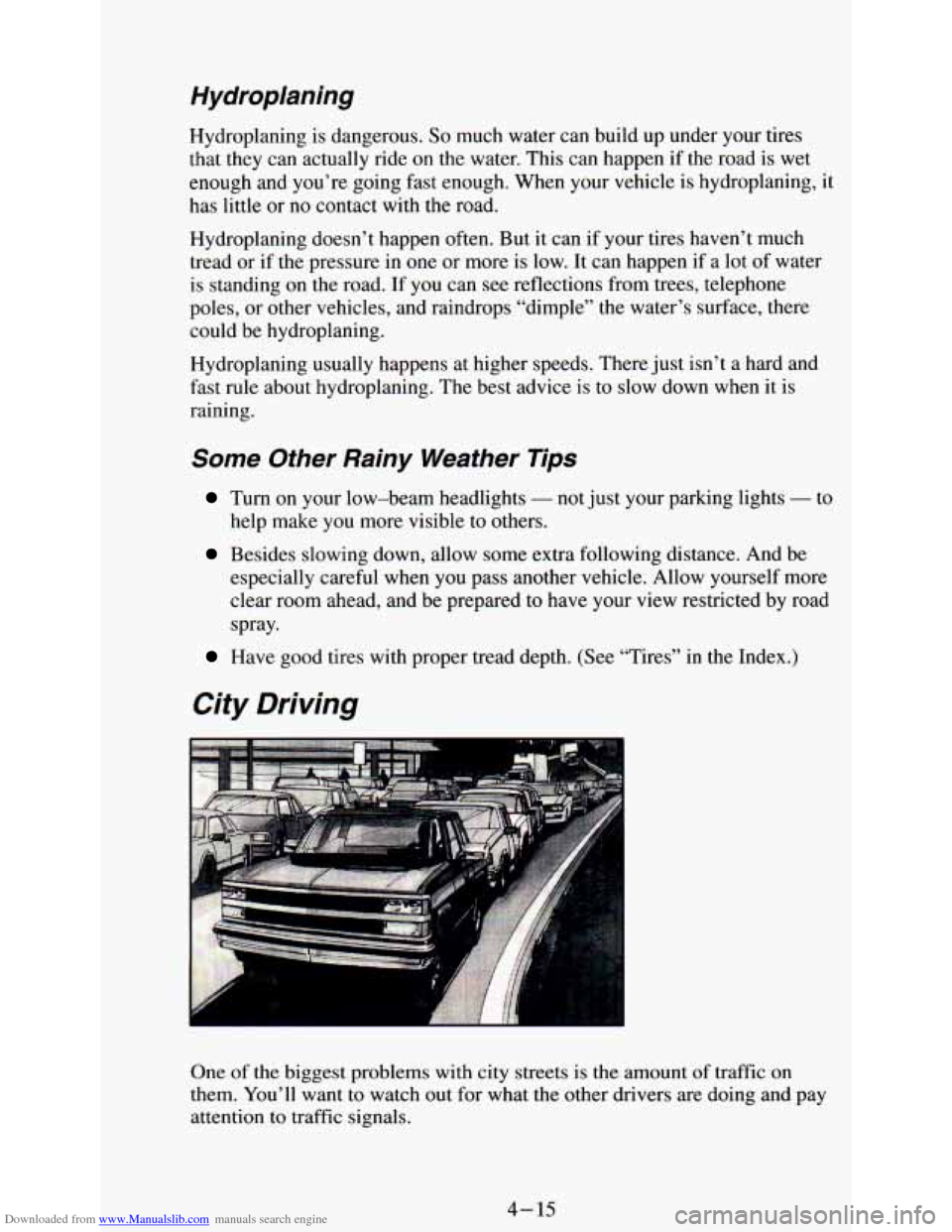
Downloaded from www.Manualslib.com manuals search engine Hydroplaning
Hydroplaning is dangerous. So much water can build up under your tires
that they can actually ride on the water. This can happen if
the road is wet
enough and you’re going fast enough. When your vehicle is hydroplaning, it
has little or no contact with the road.
Hydroplaning doesn’t happen often. But it can if your tires haven’t much
tread or if the pressure in one or more is low. It can happen if
a lot of water
is standing on the road. If you can see reflections from trees, telephone
poles,
or other vehicles, and raindrops “dimple” the water’s surface, there
could be hydroplaning.
Hydroplaning usually happens at higher speeds. There just isn’t a hard and
fast rule about hydroplaning. The best advice is to slow down when it is
raining.
Some Other Rainy Weather Tips
Turn on your low-beam headlights - not just your parking lights - to
Besides slowing down, allow some extra following distance. And be
help make you more
visible to others.
especially careful when you pass another vehicle. Allow yourself more
clear room ahead, and be prepared to have your
view restricted by road
spray.
Have good tires with proper tread depth. (See “Tires” in the Index.)
City Driving
One of the biggest problems with city streets is the amount of traffic on
them. You’ll want to watch out for what the other drivers are doing and pay
attention to traffic
sianals.
4-15
Page 171 of 340
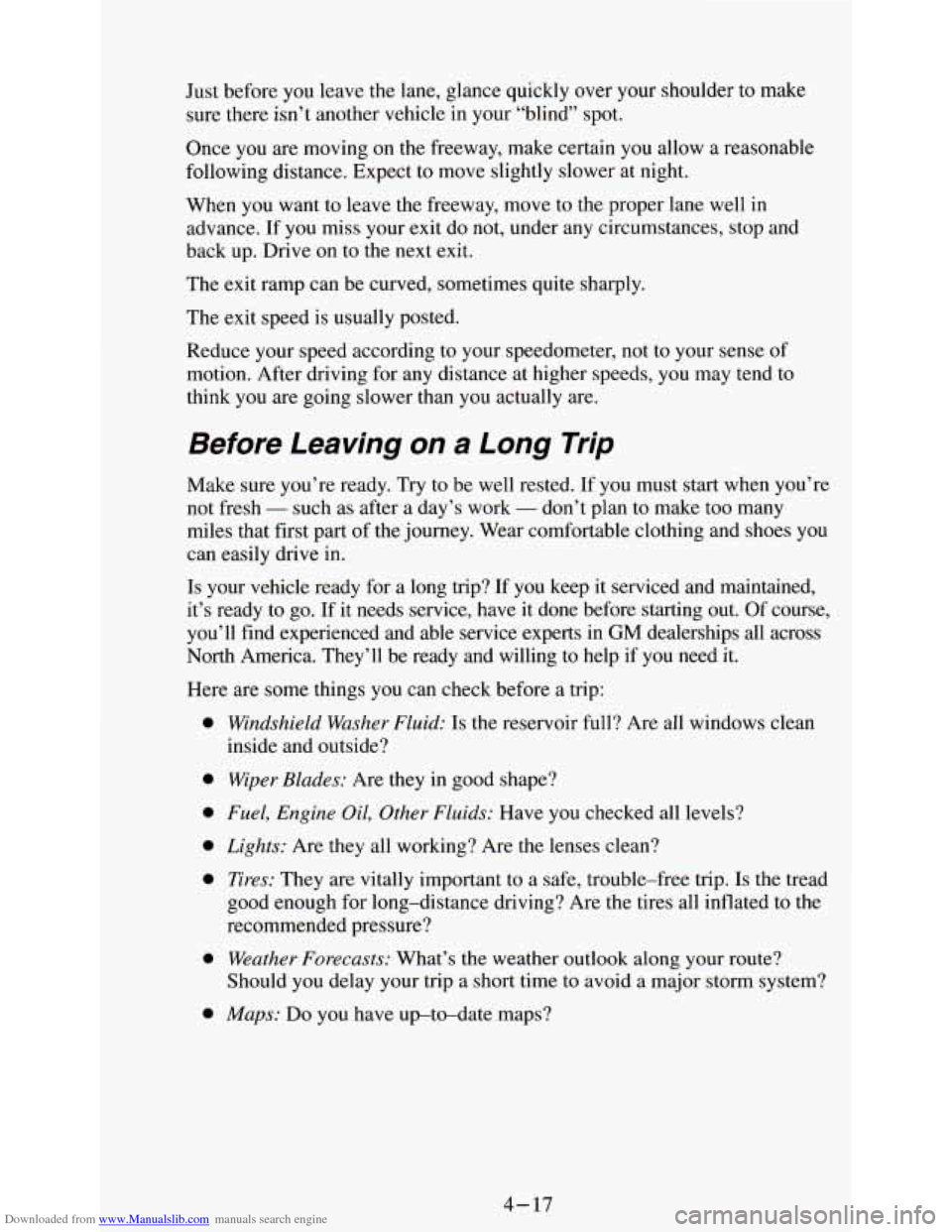
Downloaded from www.Manualslib.com manuals search engine Just before you leave the lane, glance quickly over your shoulder to make
sure there isn’t another vehicle in your “blind” spot.
Once you are moving on
the freeway, make certain you allow a reasonable
following distance. Expect to move slightly slower
at night.
When you want
to leave the freeway, move to the proper lane well in
advance. If you miss your exit do not, under any circumstances, stop and
back up. Drive on to the next exit.
The exit ramp can be curved, sometimes quite sharply.
The exit speed is usually posted.
Reduce your speed according to your speedometer, not to your sense of
motion. After driving for any distance at higher speeds, you may tend to
think you are going slower than you actually are.
Before Leaving on a Long Trip
Make sure you’re ready. Try to be well rested. If you must start when you’re
not fresh
- such as after a day’s work - don’t plan to make too many
miles that first part of the journey. Wear comfortable clothing and shoes you
can easily drive in.
Is your vehicle ready for a long trip? If you keep
it serviced and maintained,
it’s ready to go. If
it needs service, have it done before starting out. Of course,
you’ll find experienced and able service experts in
GM dealerships all across
North America. They’ll be ready and willing to help
if you need it.
Here are some things you can check before a trip:
0
0
0
0
0
0
0
Windshield Washer Fluid: Is the reservoir full? Are all windows clean
inside and outside?
Wiper Blades: Are they in good shape?
Fuel, Engine Oil, Other Fluids: Have you checked all levels?
Lights: Are they all working? Are the lenses clean?
Tires: They are vitally important to a safe, trouble-free trip. Is the tread
good enough for long-distance driving? Are the tires all inflated to the
recommended pressure?
Weather Forecasts: What’s the weather outlook along your route?
Should you delay your trip a short time to avoid a major storm system?
Maps: Do you have up-to-date maps?
4- 17